Ultius Blog
6 Myths About Student Financial Aid [Infographic]
This data-driven research article on financial aid examines the top six myths, as defined by a YouTube video the government provided on the matter. Use the following links to skip the background information and explore the infographic (which summarizes the article visually), or the myths portion.
Concerns about financial aid are probably one of the most important things on the mind of anyone who is thinking about going to college soon. This is apparent, for example, from the recent public attention that has been given to the problem of student debt. As previously reported in an Ultius blog post about student loan forgiveness, total student loan debt within the United States amounts to $1.2 trillion, mainly because the cost of secondary education has increased by upwards of 296% from 1995 to 2015.
Among other things, this suggests that without financial aid, college would so expensive for most students as to be almost prohibitive. That is, the average student debt is still at this level, even after accessing current avenues of financial aid—which would seem to suggest that in the absence of financial aid, many students may not be able to afford college at all (thanks to the rising costs in higher education).
Financial aid can take several forms, including loans, grants, and scholarships. Some forms of financial aid need to be paid back after graduation, whereas other forms are essentially just gifts to the student. Some forms are tied to one's merit or academic performance, whereas other forms are connected to one's need or financial status. Financial aid, then, is a fairly complex subject, and it is important for the prospective student to figure out the ins and outs of this subject, so that he or she may make full use of the system in his/her own favor.
| Aid Type | Repayment Terms | Notes |
| Family funding | Subjective | Not available or feasible for many families |
| Grants | None | Usually doesn't require repayment; FAFSA's Pell Grant is a key one |
| Merit scholarships | None | Distribution based on skill/talent, and not on need |
| Government loans | Low interest rate | Loans through FAFSA fall in this category |
| Private loans | High interest rate | Sallie Mae is one example |
In general, though, there is too much conflicting information regarding financial aid up on the Internet, and it can take a lot of work to filter through the material or evaluate the sources for credibility. And that's where this guide comes into the picture. More specifically, our focus (and purpose for publishing the post) is on evaluating the credibility of a video posted by Federal Student Aid on YouTube called "Myths about Financial Aid." This video has been gaining traction as of late; and it will thus be worthwhile to evaluate the claims of the video in a rigorous and critical way.
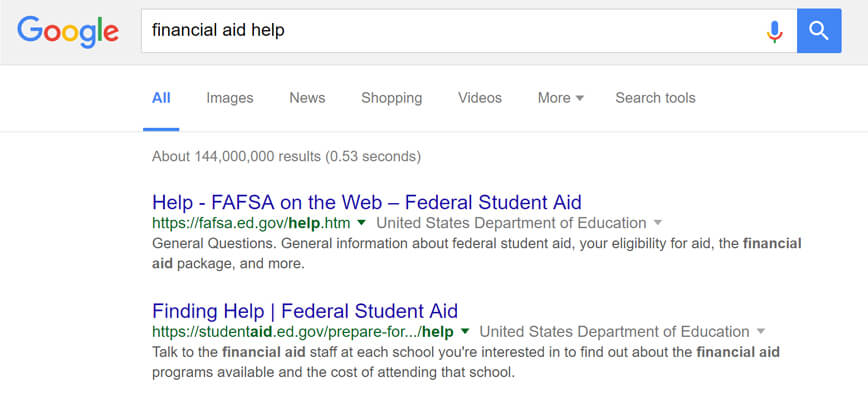
The problem of misinformation with financial aid
The main problem with applying for financial aid is that it’s just one of many steps in the process of getting a secondary education. You have to worry about taking the daunting (and ever-changing) SAT test, applying to colleges, writing admissions essays and dealing with the paperwork. It can seem for many students like a daunting and tedious prospect. And it clearly does not help that there is so much information out there about the process that it can become very difficult to know whom to trust or what information is credible. As with many Ultius blog posts, we’re here to set the record straight and back it up with objective facts and data.
That’s why we are going to evaluate several key "myths" about financial aid put forth by the Federal Student Aid video and also consider other potential myths that may have been left out. By the time that you are done reading this guide, you should have a clear and comprehensive idea of what is and is not true about applying for financial aid; and this in turn should help you with any future college application process.
Setting the record straight on financial aid - one myth at a time
So, in order to do set the record straight, this guide from Ultius will begin with a synopsis of video by Federal Student Aid: that is, it will outline the main points made by the video. Then, it will proceed to an actual evaluation of the "myths" discussed in the video, on the basis of objective and statistical evidence from the relevant research on this subject.
Then, we will review another consideration not found in the video but that may still be very relevant to you as someone who may someday want to apply for financial aid. After this, we will consider a couple of the top user comments on the Federal Student Aid video and reflect on whether the comments are accurate or out of touch with the actual research evidence.
Finally, and from this basis, a short FAQ on the subject of financial aid will be provided for you. The main idea that will emerge from this guide is that although the Federal Student Aid video may seem overly optimistic, it actually is for the most part correct, if one truly figures out how to use the system to one's own advantage.
Federal Student Aid video – Brief synopsis
The Federal Student Aid video under consideration here is structured in such a way that it discusses several key "myths" about the nature of financial aid, and then it proceeds to debunk these myths. The first myth is that a student can't get financial aid if his/her parents make too much money; the second myth is that the student must file his or her taxes before completing the FAFSA (that is, the Free Application for Federal Student Aid); the third myth is that the FAFSA is actually too difficult to fill out in an effective way; the fourth myth is that a student's grades may not be good enough to qualify for FAFSA; and the fifth myth is that the student's ethnicity or age may make him ineligible for FAFSA.
| Myth | Validity |
| Myth #1 If your parents make too much money, you won't qualify for financial aid through FAFSA. |
True |
| Myth #2 Students and parents must file their taxes before applying for financial aid. |
False, with exceptions |
| Myth #3 The FAFSA is too difficult to fill out. |
False |
| Myth #4 Having bad grades disqualifies a student from FAFSA financial aid. |
Mostly false |
| Myth #5 A student's age and race may disqualify him/her from getting financial aid. |
False, but complex |
Now, the fact that the Federal Student Aid video calls these assertions "myths" is based on the simple fact that according to the video, the assertions are quite simply untrue: the video ends with the cartoon silhouette of a person throwing the book of myths he has been reading into a trash can. So, the main point that the video wants you to get is that the five assertions are completely untrue, and that you should thus feel fully encouraged to apply for financial aid through FAFSA. Despite being a government agency, Federal Student Aid certainly seems to be taking advantage of misinformation as an advertising method to get young adults to apply.
Learn more: Read another blog post by Ultius on advertising techniques companies use to get you to buy things and why it works.
Authorship of the video – Biased or credible?
Moreover, the video is made by the same agency - Federal Student Aid - that is responsible for the FAFSA application in the first place. Federal Student Aid is an office of the U.S. Department of Education, which is a core function of the U.S. government. This would seem to suggest that the video has inherent credibility; but then, it could also mean that the video has an inherent bias. It is thus necessary to critically evaluate assertions of the video.
The nature of FAFSA
Before proceeding to that evaluation, though, perhaps a couple words should be said about the nature of FAFSA itself, insofar as a clear understanding of FAFSA is the necessary context for even making sense of the video at all. Daugherty, writing for Time magazine, has effectively summarized FAFSA in the following way:
"The FAFSA . . . that families fill out to apply for federal grants, loans, and work-study funds for college students. It is administered by the U.S. Department of Education, which provides more than $150 billion in student aid each year.”
So, an important point to understand here is that FAFSA is financial aid that is provided directly for the student by the American government. This is the main focus of the video under consideration here, and this is different from other forms of financial aid that may be provided by private stakeholders or by colleges and universities themselves. And like most government based financial assistance programs in recent history, much of it is based solely the unique financial needs of the individual (and parents because it determines the expected family contribution - EFC). Many of the myths are going to center around this important theme.

Myth #1: If your parents make too much money, you don’t qualify for financial aid [True]
The first myth in the video is that the student's family may make too much money for the student to qualify for financial aid through FAFSA. An initial review of the evidence would seem to suggest that this is not actually a myth at all but rather a fact. Just like welfare in the United States, if you make too much money you just don’t qualify for the benefits. Our extensive review of Pell Grant data illustrates just that.
The Pell Grant is an important form of financial aid distributed by Federal Student Aid. And in a white paper on this subject written by Fastweb, it was reported that the average median income for the Pell Grant recipients was $20,302, whereas the average median income for non-recipients was $59,083; and moreover, it was found that fully two-thirds of Pell Grant recipients had family income less than 150% of the poverty line, and that fully 95 percent of all Pell Grant recipients had family income less than 250% of the poverty line. While poverty does impact one’s educational attainment, it also determines whether you actually get a Pell Grant or other forms of financial aid. See some Pell Grant data below for more insight.
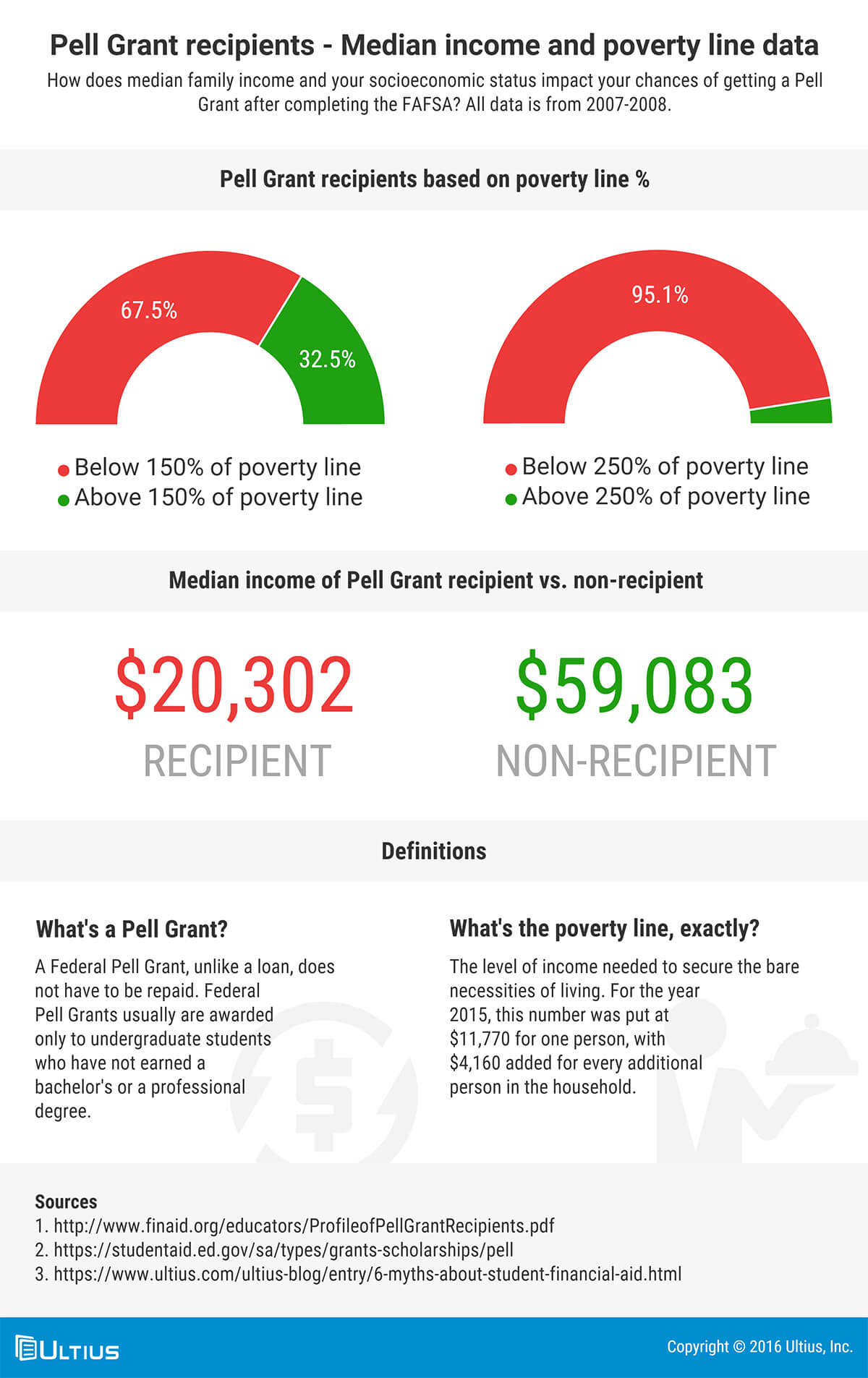
Important Definition - The poverty line: the level of income needed to secure the bare necessities of living. For the year 2015, this number was put at $11,770 for one person, with $4,160 added for every additional person in the household (U.S. Department of Health and Human Services).
This evidence would seem to strongly suggest that the level of one's family income does in fact play a huge role in whether or not one will qualify for a Pell Grant. And insofar as this is true, it means that Federal Student Aid is mistaken in arguing that the idea of the student's family making too much money for the student to qualify for financial aid is actually a myth.
The self-fulfilling prophecy of making too much money
On the other hand, it may also be possible that there is some element of the self-fulfilling prophecy (also called the Pygmalion effect) in play, here. Here's an image from Carolyn Kaufman of Psychology Today that indicates how this works:
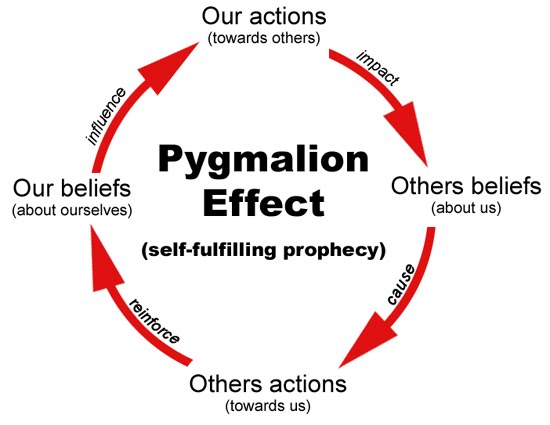
In the present context, what this could mean is that part of why students from higher-income families get less financial aid through FAFSA is that they have it in their heads that they are too wealthy for the aid—and thus don't even bother filling out the application. It is also worth remembering here that there are several other forms of financial aid through FAFSA other than the Pell Grant. And as Troy Onink of Forbes has related, for example, he knew a family who didn't think it was worthwhile to fill out FAFSA, but:
"the truth is that if they had only applied their daughter would have qualified for over $17,000 per year in aid at the private college she attended.”
So, while the income level of the student's family clearly does affect the likelihood that one will get certain forms of financial aid through FAFSA, Federal Student Aid may be at least somewhat justified in calling the idea a myth in the video, even though the organization probably overstates its case for the sake of being as persuasive as possible.
Myth #2: You have to file your taxes before you can apply for financial aid [False, with a Caveat]
The second myth discussed in the video is that it is necessary for the student to file his/her taxes before filling out the FAFSA. This straightforwardly is a myth: the fact is that one does not need to file one's taxes before applying for FAFSA, and that it would actually be a very bad idea to wait that long. As Mandi Woodruff has written for Business Insider, waiting until April - that is, tax season - to apply for FAFSA is
"a big no-no, especially as many states have their own specific deadlines (usually in the early spring) and late-comers will have to make do with whatever money's left on the table—if there's anything at all.”
In short: Apply for FAFSA as soon as possible, and don't wait until you've filed your taxes. Federal Student Aid is thus very much correct in identifying this as a crucial myth regarding financial aid. The fact is that if the student waits too long to apply for FAFSA, then his/her odds of actually receiving aid goes significantly down.
Are you going back to college? Check out scholarship opportunities and financing for adults going back to school.
A crucial caveat – Estimated income reporting on the FAFSA
It is important, though, to make note of a caveat that has been snuck into the video, almost in an undertone (like those drug commercials that only quietly indicate the potential side effects of taking the drug): the student and his/her family must make sure that they make accurate estimations regarding their income and predicted tax liability, because otherwise, the amount of financial aid that the student receives will be adjusted later according to the actual information.
To quote Woodruff again:
"The Dept. of Education and IRS are working together to crack down on families who under-report their taxable income on FAFSA forms . . . in the hopes of lowering the existing 4-5% fraud rate.”
In other words, being able to use estimated tax information for the FAFSA does not give the you the liberty to simply make up information with the hope of receiving more money in financial aid. If you try this, you will probably get caught (and face jail time), and this will become a substantial headache in the future. If you make plans on the basis of financial aid you received as a result of false estimates, it will be revoked after it has been initially granted. Even worse, according to the Higher Education Act of 1965 [20 USC 1097(a)], you can face these penalties:
- Penalties for fraudulent FAFSA income reporting
- Fine of up to $20,000
- Up to 5 years of jail time
- You will have to give the money back
Additionally, because the FAFSA is related to your taxes you may even get in hot water with the Internal Revenue Service. In 2014, the FBI even issued a public awareness notice regarding Pell Grant fraud. The bottom line – don’t do this. It’s fraud and you will get caught.

Myth #3: The FAFSA is just too difficult to fill out, and thus not worth the aid [False]
The third myth discussed in the video is that the FAFSA is in fact too difficult to effectively fill out. Now, it is somewhat challenging to reach a firm conclusion about this myth, due to how subjective the basic assertion is: obviously, what is difficult for some people may come very easily to others. To quantify this myth, we are going to compare the savviness required to fill out the form to the use of popular social media networks. Finally, we actually went through the process of filling out the FAFSA at a reasonable pace and created a chart to show how long it took.
Comparative example of social media use
Let us turn to data regarding social media usage for the sake of analogy. Social media is a worth-while example because in the last decade so many people have turned to social media as a way to spend time communicating with others. According to Andrew Perrin, writing for Pew Research Center, fully 90 percent of all people between the ages of 18 and 29 use social media, whereas as only 35 percent of people 65 years of age or older make use of this technology.
| Ages | % Using Social Media |
| 18-29 | 90% |
| 65+ | 35% |
Presumably, at least part of the reason for this discrepancy would be that young adults, having grown up with social media (and use it to the point of it being an addiction), find it a lot easier to use the technology than do older adults. It would be difficult, though, to reach a conclusion about how objectively "difficult" using social media really is. But, the fact remains that if over half the population uses complex (and ever-changing) social media sites on a daily basis (including desktop and mobile apps), it is plausible to presume that this represents enough competency to fill out the FAFSA forms.
Filling out the FAFSA form – How long does it really take?
In any event, FAFSA is a pretty standard bureaucratic form that looks like any other government form. It may look tedious, but you can fill it out online by going to the website for Federal Student Aid: https://fafsa.ed.gov/.t If you are old fashioned and want to complete it using pen and paper, you can download a PDF copy of the form for the 2016-2017 year. It’s a whopping ten pages long, but the form fields are located in five of them.
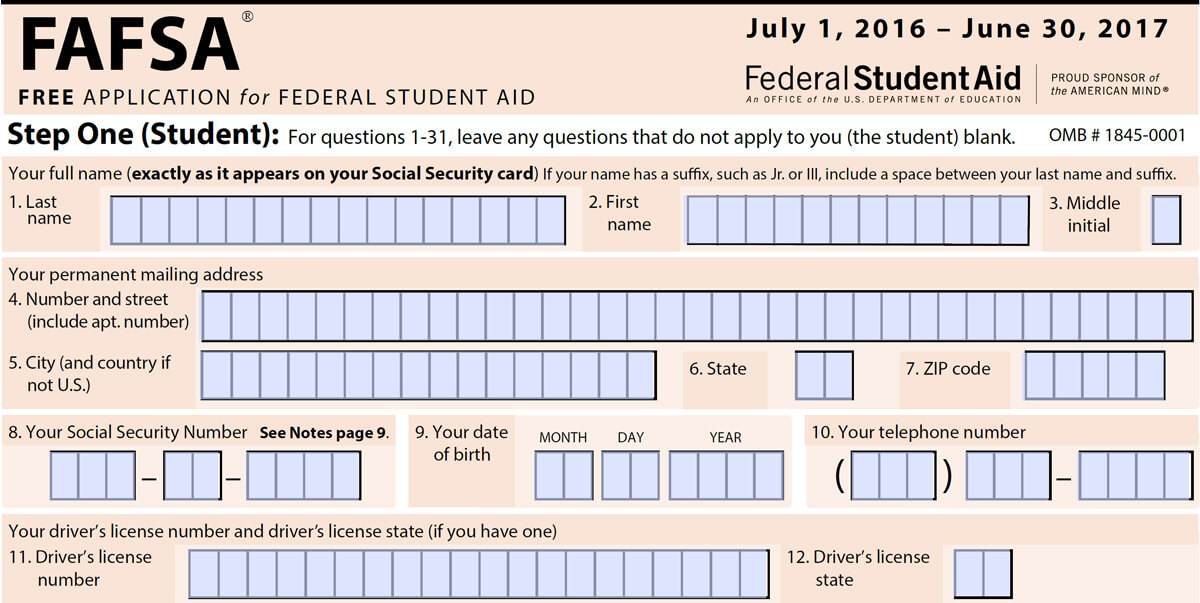
And speaking about the matter as objectively as possible, it would seem fair to state that the process for filling out FAFSA is not really a difficult one. Think of it like doing your taxes: it may be very tedious, and you would definitely prefer to be doing other things, but once you put your mind to it and decide to actually take care of it, you should really not encounter any serious difficulties. Also remember that it would be easy enough to find an advisor to help you with the process if you actually do find the process too hard to see through in a successful way.
Filling out the FAFSA – Completion study
We did an internal experiment by having an Ultius writer complete the form from start to finish at a reasonable pace. The results were that it took under an hour.
| Step | Duration (minutes) |
| 1. Visit fafsa.gov | 1 |
| 2. Log in using FSA ID | 5 (first time user) |
| 3. Choose form (student or parent) | 1 |
| 4. Enter personal information | 10 |
| 5. Enter financial information | 30 |
| 6. Choose up to 10 schools | 10 |
| 7. Sign document with FSA ID | 1 |
| Total Time Spent | 58 Mins |
Arguing that the FAFSA takes too long to fill out or is difficult is therefore a myth. Most high school curriculums require students to learn how to fill out basic tax forms (W-2 and others), and the FAFSA application is not much different. The video is therefore correct in debunking this myth.
Myth #4: My GPA is too low to qualify for financial aid [Mostly False]
The fourth myth discussed by the video is that the student's grades may not be good enough for him or her to qualify for financial aid. We can see why this is a common concern – overall educational attainment has gone down over the past few decades. In another Ultius blog post where we researched literacy (scroll down to the infographic), the data showed that teen reading rates (which are highly related to educational success at the high school and college level) were in decline. If the trend in education is poor student performance, then millions of would-be students may be avoiding the FAFSA out of fear of being rejected for poor scholarship.
Broadly speaking, the video is correct to call this a myth, insofar as the financial aid distributed through FAFSA is generally based on an evaluation of financial need and not academic merit. According to Fastweb LLC, this is the breakdown for the GPAs of the recipients of the Pell Grant (which is, again, an important form of financial aid distributed through FAFSA):
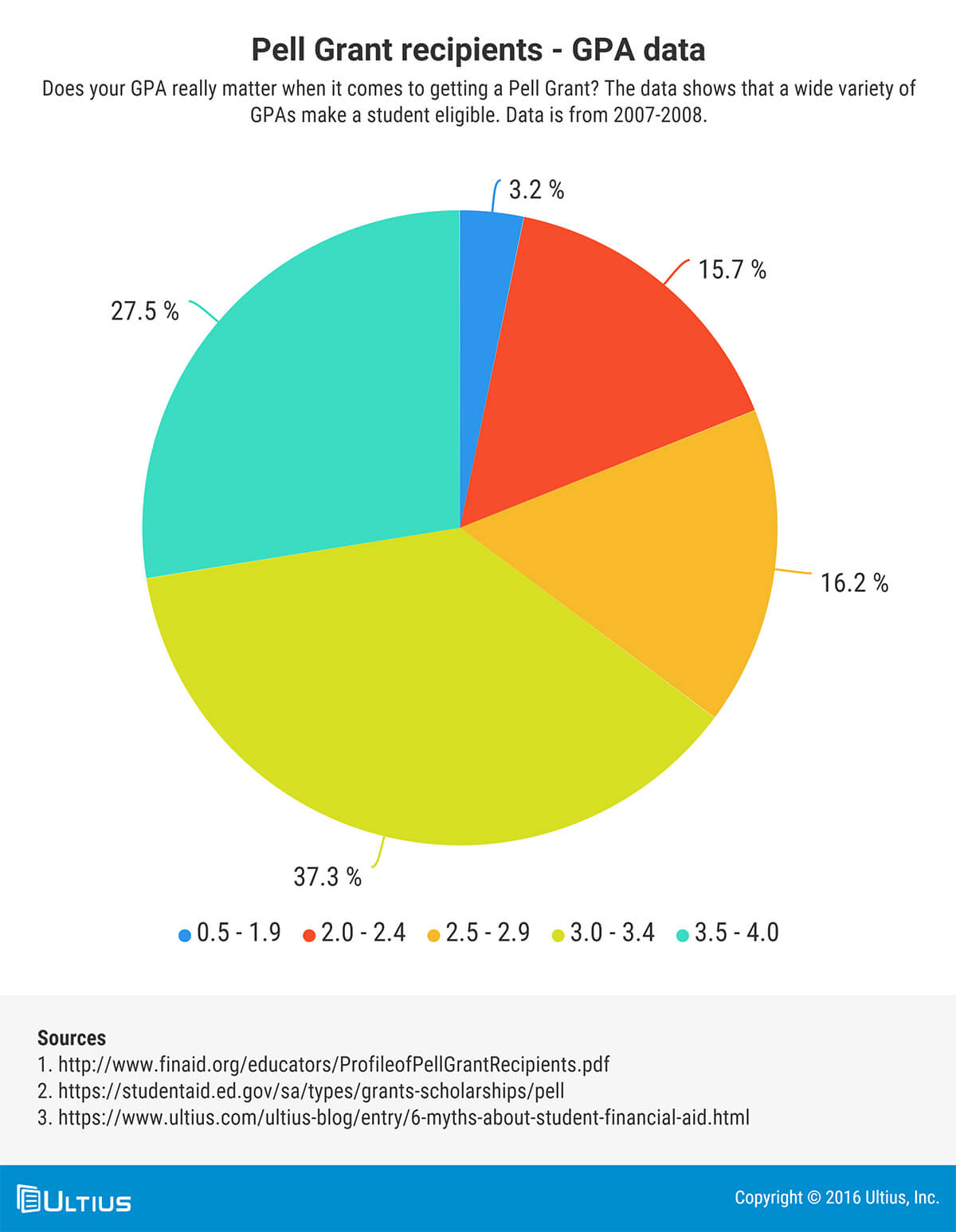
As you can see from this chart, over half of all the recipients of the Pell Grant in this data set actually had a GPA that was not between 3.0 and 4.0; and some recipients (albeit not many) had a GPA that would have put them in the D- to C grade range. This would seem to confirm the Federal Student Aid video's assertion that it is myth that one's grades may be too low for one to qualify for FAFSA.
Important considerations when interpreting the recipient GPA data
However, two reservations need to be added to this conclusion here. The first is that it actually is true that about a full half of the recipients of financial aid through FAFSA actually do have a good GPA. It may be possible, though, to explain at least part of this through the mechanism of the self-fulfilling prophecy again. That is, students with lower grades may be under the impression that they will not qualify for aid through FAFSA; therefore, they may not even bother applying for such aid; and they would thus of course end up not getting the aid.
Secondly, it should also be noted that although lower grades may not be an obstacle to FAFSA, the student must still take care to make sure that he/she meets his/her school's own academic requirements: after all, one cannot be a recipient of financial aid through FAFSA if one gets kicked out of school for having low grades. Planning for the future, academic performance may be a stronger determinant of how much funding you receive for school. For example, in 2015 President Obama announced his plan for free community college and a core requirement was keeping a 2.5 or higher GPA. But this plan was just a proposal, so don’t think that it’s going to happen any time soon.
Myth #5: My age and ethnicity (demographics) disqualify me from attaining financial aid [False, but complex]
Finally, the fifth myth covered by the Federal Student Aid video is that the student's age and/or ethnicity may disqualify him or her from receiving financial aid through FAFSA. The video would seem to be correct in affirming that this actually is a myth. More specifically, as Mark Kantrowitz of FinAid.org has written regarding the Pell Grant:
"While minority students are more likely to receive such need-based grants than Caucasian students, the distribution is largely consistent with the prevalence of minority students in the low-income student population.”
That is, it would seem to be true that minority ethnic/racial students are more likely to get Pell Grants than white students. But this is not because of their ethnic/racial status; rather, it is because they are actually more likely to be from low-income backgrounds than white students and thus more likely to qualify for the need-based financial aid.
| Race/Ethnicity | % of Total Pell Grant Funds Distributed |
| Recipient | |
| White | 46.3% |
| Black | 23.7% |
| Hispanic | 20.4% |
| Asian | 4.8% |
| Non-Recipient | |
| White | 67.6% |
| Black | 10.3% |
| Hispanic | 11.8% |
| Asian | 6.3% |
The data represented in the table above indicates that the almost half of the financial aid distributed through the Pell Grant program does in fact go to minority students. Additionally, during the course of our research we found that two credible sources had conflicting data for the same time periods - 2007 and 2008. Fastweb's Pell Grant data (in the table above) indicated that minorities received less than half of the funds, while data gathered from Mark Kantrowitz (FinAid.org) showed minorities receiving almost 55% of Pell Grants. It's a pretty statistically significant difference, so we stuck with the middle ground - half.
Nonetheless, this would initially seem to suggest that the Federal Student Aid video is wrong to identify this as a myth. The crucial point to remember here, however, is that the minority students are not receiving the financial aid because they belong to a racial/ethnic minority, but rather simply because there is an overlap between the minority population on the one hand and the low socioeconomic status population on the other. As far as our research shows, educational loan funding from the government has not been subject to affirmative action based on race or ethnicity.
Age doesn’t matter either
Similarly, when it comes to age, it would surely be true that people of a certain age are far more likely to be the recipient of financial aid through FAFSA than others. But then, this is just because most people applying for FAFSA fall within a certain age bracket (i.e. young adult). Ultimately, age does not imply that one will be automatically disqualified from FAFSA if one does not fall within that age bracket. In short, it is necessary to evaluate the statistical evidence in a critical way, because the actual evidence may produce misunderstandings if they are interpreted in a superficial way.
In general, the conclusion could be reached that it actually is true that one's age and/or ethnicity does not affect one's FAFSA eligibility. The data is just based on the complex overlaps between different demographic categories.
A Sixth Myth: Federal Funding of Financial Aid
A potential sixth myth not found in the video is that the federal government actually provides most of the financial aid available to students. It is worth remembering here that the Federal Student Aid under consideration here only addresses the need-based financial aid administered through FAFSA.
So, if you are concerned about not qualifying for such aid, it is also worth bearing in mind that a vast amount of money from other stakeholders is distributed on the basis of merit-based considerations, as well as other criteria not used for money distributed through FAFSA. According to the Center for Education Statistics, for the 2007-2008 academic year, a total of $62 billion was distributed to students across the nation, with only $22 billion of this amount coming from the federal government.
| Source of Funds | Amount Distributed (2007) |
| Federal government | $22 Billion |
| All other sources | $40 Billion |
| Total | $62 Billion |
According to this data, only 35.5 percent (or a little more than one-third) of all financial aid comes from the federal government, and the FAFSA application covered by the Federal Student Aid video only addresses financial aid that comes from the federal government. Even with President Obama’s eight years in office and most recent 2014 fiscal policy plan, no mention of expanding federal funding for education has seen the light of day (other than the free community college proposal cited earlier in this article).
The point here is that there is a huge diversity of different sources that can be tapped in the student's search for financial aid; so, even in the event that one cannot get help through FAFSA, there is little reason for despair. According to the same source cited above, over half of all college students in the 2007-2008 school year were able to obtain some kind of financial aid from some source or another. So, you should do your best to look everywhere that you can for this help. Because the business of Ultius is to connect you with a writer, we would also recommend that you spend lots of time working on your college application essays and consider buying a personal statement. After all, it is your first impression to potential colleges and may help increase the amount of scholarship (merit based aid) money you receive.
Addressing the top user comments for the video about financial aid
In the spirit of addressing how confused people were about the topic and video in general, we also decided to look at the top user comments and address them as well. Please excuse the expletive language for some of the comments.

The top YouTube comment for the Federal Student Aid video reads the following:
"I will stop at 1 . . . it is not a 'myth' it is a fact that if you make too much, then you are screwed. I don't depend on my parents, I pay my own tuition, yet, I feel that the system punishes those who make a bit more."
This is referring to the first myth in the video. And according to the analysis that has been conducted in the present guide, it would be fair to conclude that this commenter does have something of a point. FAFSA is, of course, a need-based form of financial aid distribution; therefore, if one cannot demonstrate real financial need, then one will probably not qualify for FAFSA; and if one's parents make a good amount of money, then it would be difficult to demonstrate such need.
Again, it would seem that the Federal Student Aid video does overstate its case by calling this a myth. Rather, it is a simple structural feature of the entire FAFSA program itself.
The role of parents – does it matter?
Another top comment on the video says this:
"Lmao why is financial [aid] on the basis that your parents will pay? My parents hate me"
A previous Ultius blog post on the importance of family support found that having a strong support system is an indicator of future success. And unfortunately, this comment makes a strong point in that regard. The fact is that when FAFSA asks for parental information, it does not evaluate the quality or nature of any given student's relationship with his own parents; rather, it simply assumes that if parents have money, they would be able and willing to give it to the student for college expenses. In a real world scenario, parents may contribute only a small portion of their earnings to a child’s college education, if any. On top of that, the declining middle-class of America has seen its savings deposits wiped out by rising costs and stagnant wages. On these grounds, it’s easy to see why so many people can relate to this comment. The government expects parents to contribute, but it’s not always realistic or opportune.
As is accurately pointed out in the Federal Student Aid video, however, there are ways in which one may be eligible for consideration as an independent adult by FAFSA, including being 24 years of age, married, or having served in the military. Former members of the military may also qualify for some specific education loan programs, but these won’t come close to covering the full cost. In short, if one wants one's parents' information to be left out of FAFSA, there may be ways in which this goal could be achieved.
Addressing other frequently asked questions about financial aid
Now that we have covered the top YouTube comments and evaluated the evidence, let's look at other common questions students have about financial aid. Here are some FAQs we found to be common.
Q: Is applying for FAFSA worth my time?
A: In general, the point can be made that every student should at least try applying through FAFSA for financial aid from the federal government. The application process is not all that difficult to fill out, and one way or the better, it would be better to just do it, as opposed to kicking oneself later and wondering if one could have received more financial assistance.
Q: Will my parents' income affect whether I get aid through FAFSA?
A: Yes, it will. This is the one point about the Federal Student Aid video that is quite misleading: in its zeal to get people to apply for FAFSA, it may overstate its case and give people false hope. FAFSA is a need-based financial aid program, and the level of income of one's family will thus of course strongly influence whether one receives aid.
Q: Will other demographic factors affect whether I get aid through FAFSA?
A: No, they will not. As the analysis above has shown, it may seem like minority racial/ethnic students receive a disproportional amount of financial aid through FAFSA. However, this is simply become within contemporary America, there is a correlation between being a minority on the one hand and making less money on the other. If minority students are more likely to get FAFSA, then this is not because they belong to a minority but rather simply because they may often have more financial need.
Q: Will my grades affect whether I get aid through FAFSA?
A: Technically speaking, your grades may not be an important factor for FAFSA eligibility. However, it is worth pointing out that it is still worth making sure that your grades are good anyway. Most colleges have their own requirements in this regard, and in any event, of course you want to be as successful as possible within your academic career.
Summarizing the key takeaways
In summary, this guide has consisted of a comprehensive analysis of key myths regarding financial aid, based on Federal Student Aid's video on this subject. After introducing the subject, defining the problem of financial aid misinformation, and providing a synopsis of the video, the guide proceeded to evaluate the truth of the myths, one by one. Then, it considered a sixth possible myth not included in the video, which is that the federal government provides most of the available financial aid for students (which is false). Finally, the guide reviewed a couple top comments on the YouTube video and then proceeded to develop a short FAQ on financial aid for you.
On the basis of this critical analysis and evaluation, a main conclusion that can be reached is that the information found within the Federal Student Aid video is mostly true. For example, the FAFSA application is not in fact too difficult to fill out; it is not necessary to file one's taxes before filling out the application; and one's grades, race/ethnicity, and age are not criteria that are considered important for FAFSA eligibility.
A second conclusion that must be drawn here, however, is the Federal Student Aid video does in general seem to be a tad too optimistic. In particular, it fudges its information on the crucial point that the financial status of a student's family will of course have a dramatic influence on whether or not he/she receives financial aid through FAFSA.
Nevertheless, though, the point can be made that it would in fact be a good idea for every prospective college student to apply for FAFSA and to not simply disqualify himself/herself by failing to fill out the application at all. And if you end up not receiving financial aid through FAFSA, remember that it is not the end of the world. FAFSA only pertains to the federal government, and there are numerous other stakeholders who provide almost two-thirds of all the financial aid distributed within the nation. So, go forth and search!
If you enjoyed this article, consider checking out other blog posts from Ultius.
Works Cited
Daugherty, Greg. "What Is FAFSA and Who Should Fill It Out?" Time. 13 Nov. 2015. Web. 22 Sep. 2016. <http://time.com/money/4108122/what-is-fafsa-and-who-should-fill-it-out/>.
Fastweb LLC. Profile of Pell Grant Recipients Quick Reference Guide. Author, 2011. Web. 22 Sep. 2016. <http://www.finaid.org/educators/ProfileofPellGrantRecipients.pdf>.
Federal Student Aid. "Myths about Financial Aid." YouTube, 30 Apr. 2013. Web. 20 Sep. 2016. <https://www.youtube.com/watch?v=K8JuaYVJ_LE&feature=youtu.be>.
Jackson, Abby. "This Could Be the 'Single Most Important' Reason Why College Tuition is Skyrocketing." Business Insider. 9 Sep. 2015. Web. 20 Sep. 2016. <http://www.businessinsider.com/this-could-be-the-single-most-important-reason-why- college-tuition-is-skyrocketing-2015-9>.
Kantrowitz, Mark. "The Distribution of Grants and Scholarships by Race." FinAid.org, 2 Sep. 2011. Web. 22 Sep. 2016. <http://www.finaid.org/scholarships/20110902racescholarships.pdf>.
Kaufman, Carolyn. "Using Self-Fulfilling Prophecies to Your Advantage." Psychology Today. 11 Oct. 2012. Web. 22 Sep. 2016. <https://www.psychologytoday.com/blog/psychology- writers/201210/using-self-fulfilling-prophecies-your-advantage>.
National Center for Education Statistics. Merit aid for Undergraduates. Author, 2011. Web. 23 Sep. 2016. < http://nces.ed.gov/pubs2012/2012160.pdf>.
Onink, Troy. "Do You Earn Too Much Money to Qualify for College Financial Aid?" Forbes. 31 Mar. 2015. Web. 22 Sep. 2016. < http://www.forbes.com/sites/troyonink/2015/03/31/do- you-earn-too-much-to-qualify-for-college-financial-aid/#7c2590158cec>.
Perrin, Andrew. "Social Media Usage: 2005-2015." Pew Research Center, 8 Oct. 2015. Web. 22 Sep. 2016. <http://www.pewinternet.org/2015/10/08/social-networking-usage-2005- 2015/>.
U.S. Department of Education. "7 Steps to Filling Out the FAFSA." HomeRoom. n.d. Web. 28 Sep. 2016. <http://blog.ed.gov/2015/12/7-steps-filling-out-fafsa/>.
U.S. Department of Health & Human Services. "2015 Poverty Guidelines." ASPE, 3 Sep. 2015. Web. 28 Sep. 2016. <https://aspe.hhs.gov/2015-poverty-guidelines>.
Woodruff, Mandi. "The 7 Easiest Ways to Blow Your FAFSA." Business Insider 29 Feb. 2012. Web. 22 Sep. 2016. <http://www.businessinsider.com/these-are-the-7-easiest-ways-to- slip-up-on-your-fafsa-form-2012-2>.
Cite This Post
This blog post is provided free of charge and we encourage you to use it for your research and writing. However, we do require that you cite it properly using the citation provided below (in MLA format).
Ultius, Inc. "6 Myths About Student Financial Aid [Infographic]." Ultius Blog. Ultius | Custom Writing and Editing Services, 10 Oct. 2016. Web. <https://www.ultius.com/ultius-blog/entry/6-myths-about-student-financial-aid.html>
Thank you for practicing fair use.
This citation is in MLA format, if you need help with MLA format, click here to follow our citation style guide.
- MLA Style
- APA Style
- Chicago Style
- Turabian
Ultius, Inc. "6 Myths About Student Financial Aid [Infographic]." Ultius | Custom Writing and Editing Services. Ultius Blog, 10 Oct. 2016. https://www.ultius.com/ultius-blog/entry/6-myths-about-student-financial-aid.html
Copied to clipboard
Click here for more help with MLA citations.
Ultius, Inc. (2016, October 10). 6 Myths About Student Financial Aid [Infographic]. Retrieved from Ultius | Custom Writing and Editing Services, https://www.ultius.com/ultius-blog/entry/6-myths-about-student-financial-aid.html
Copied to clipboard
Click here for more help with APA citations.
Ultius, Inc. "6 Myths About Student Financial Aid [Infographic]." Ultius | Custom Writing and Editing Services. October 10, 2016 https://www.ultius.com/ultius-blog/entry/6-myths-about-student-financial-aid.html.
Copied to clipboard
Click here for more help with CMS citations.
Ultius, Inc. "6 Myths About Student Financial Aid [Infographic]." Ultius | Custom Writing and Editing Services. October 10, 2016 https://www.ultius.com/ultius-blog/entry/6-myths-about-student-financial-aid.html.
Copied to clipboard
Click here for more help with Turabian citations.



